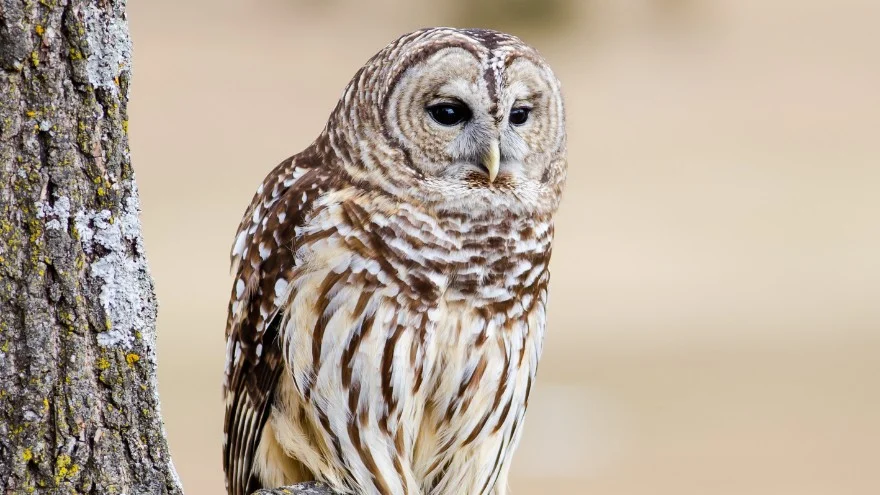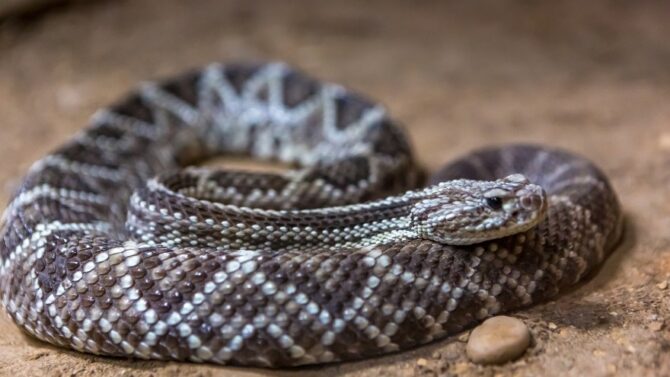Wisconsin can be found in the upper midwest of the United States, and it is bordered by other states like Michigan, Minnesota, Iowa, and Illinois.
It is also bordered by Lake Michigan and Lake Superior. Like many other states, it contains different forms of wildlife, one of which is the owl.
There are up to eleven species of owls in Wisconsin. They include the great horned, Northern hawk owl, barn owl, Eastern screech owl, and boreal owl, among others.
Read on to discover interesting facts about these birds and how to recognize the different species based on their appearance, sounds, and migratory patterns.
The 11 Species of Owls in Wisconsin
1. Great Horned Owl
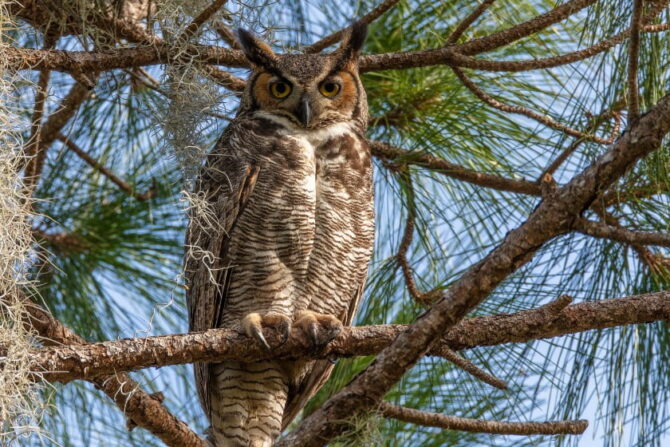
- Length: 18 to 25 inches
- Weight: 32 to 88 pounds
- Wingspan: 40 to 57 inches
- Scientific name: Bubo virginianus
The great horned owl is also known as the tiger owl or the hoot owl. It is a native of the Americas, which is why you can find it in Wisconsin.
In the state, the great horned owl inhabits woodlands, canyons, and cliffs. It also lives in farmlands.
It is the most widely distributed true owl in the Americas and can be found in many other states in the US.1
This bird is nocturnal, and the best time to ever find one is at night when it comes out to hunt. Good luck trying to hear it fly by, though.
The great horned owl has fluffy, silent wings, which makes it fly without a sound. It is made for camouflage with its mottled brown upper body and lighter brown underneath. It also has bars all over.
Its diet includes mainly rodents, though it can go after birds and reptiles.
2. Barred Owl
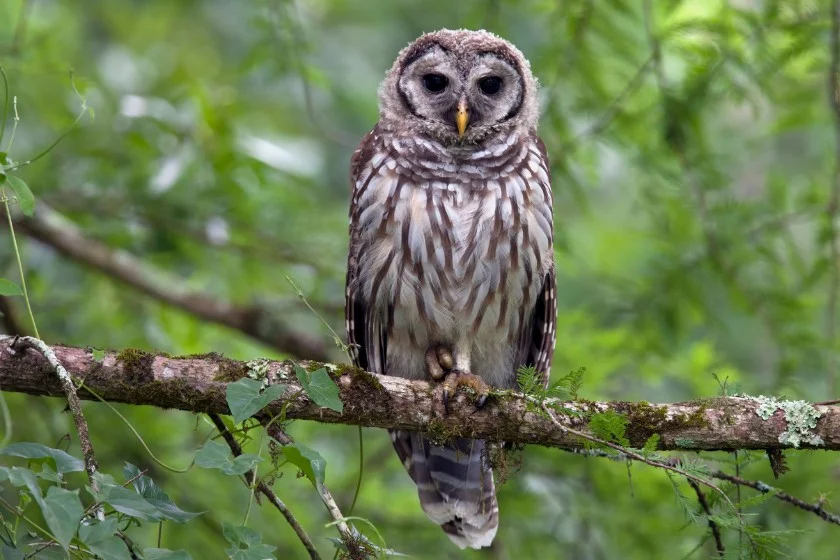
- Length: 17 to 20 inches
- Weight: 16 to 37 pounds
- Wingspan: 39 to 43 inches
- Scientific name: Strix varia
The barred owl goes by different other names like the striped owl, the hoot owl, and the northern barred owl.
It is a large species found in North America, including Wisconsin. In the latter, the barred owl inhabits deciduous forests. The best place to sight it is close to lakes.
True to its name, the barred owl comes with white bars on the mantle and back. In general, it is colored either greyish brown or just a simple brown, which is considered dull compared to some other species.
Additional physical traits you can use to identify it are the large head, eyes that are brackish brown, and spots on the wing coverts.
The barred owl can also be traced by its call, which earned it the alternative name “hoot owl”. Its hooting can go as far as 0.8km, and it sounds like ok-ok-ok-ok-ok-buhoooh.
This bird is also nocturnal, a feature that’s common amongst owls. It sleeps from 5:00 a.m. to 8:00 p.m. and starts off its night after sunset.
That said, you’re more likely to sight a barred owl in the morning than you would a great horned.
3. Northern Hawk Owl
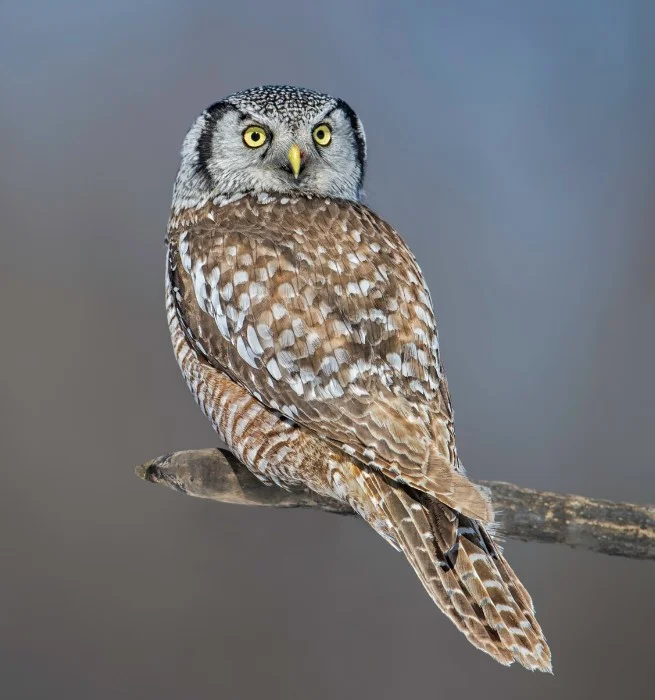
- Length: 14 to 18 inches
- Weight: 8 to 16 pounds
- Wingspan: 28 inches
- Scientific name: Surnia ulula
The Northern hawk owl is rarer in Wisconsin than the aforementioned species and usually would be sighted once every four months.
Sometimes it is termed the hawk owl, though that name can be used to designate some other species.
This bird comes with a plumage that’s dark brown with a tinge of white on it at the upper parts. The lower parts are white.
Females tend to be bigger than males, but both have similar wingspans. Other physical attributes it has are yellow eyes, a large head, and an equally yellow beak. The latter is curved.
The vocal sound of the hawk lookalike is a whistle that goes ululululululul. However, it makes a different sound when it is in danger.
At that point, its sound changes to something similar to a rike, rike, rike, rike, or a loud yip.
The Northern hawk owl is one of the few species that are diurnal. You can easily see it during the day as it is active then.2
At night, it retires to sleep. Its diet is vast, ranging from rodents to mammals.
4. Boreal Owl
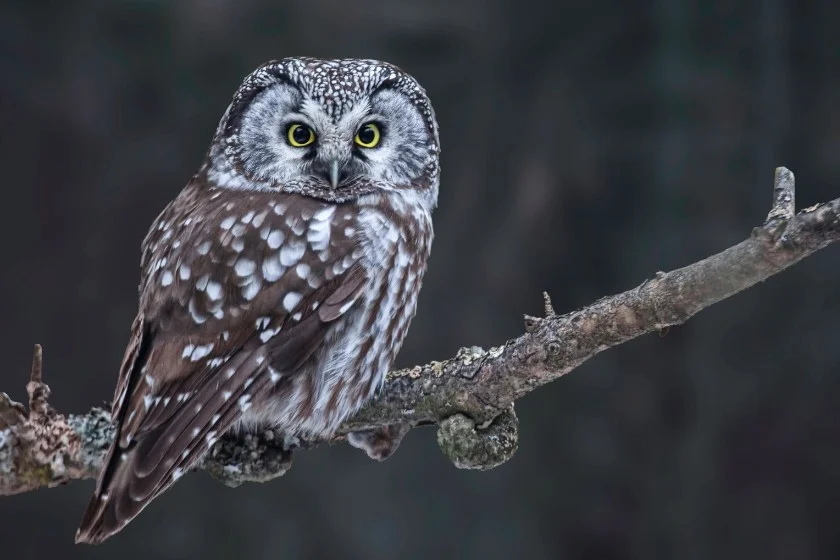
- Length: 8 to 11 inches
- Weight: 3 to 8 pounds
- Wingspan: 22 to 24 inches
- Scientific name: Aegolius funereus
The boreal owl is also called the Tengmalm’s owl in the European regions. A seldom-used name is Richardson’s owl.
It is usually found in North America, and it isn’t migratory but can move during autumn. In Wisconsin, you’d often find it on trees like poplar and spruce.
A defining characteristic of this small bird is the absence of ear tufts. It is also known for its size and color.
The overall plumage color is brown, with white specks at the shoulder. Its head is large, its eyes are yellow, and its face is white. It generally lives in boreal regions, hence the name.
Because of its size, shyness, and nocturnal lifestyle, the boreal owl is hard to see.
This small size can turn out to be a disadvantage as the owl becomes easy prey to many other predators. It seldom reaches its full lifespan of 16 years.
If you hope to see the boreal owl, you need to familiarise yourself with its sound. The males toot during the breeding season, and it comes out like singing.
This is done in a bid to attract a female. At other times of the year, all boreal owls let out a short kip or kew.
5. Great Gray Owl

- Length: 24 to 33 inches
- Weight: 25 to 60 pounds
- Wingspan: 54 to 60 inches
- Scientific name: Strix nebulosa
The great gray owl (also spelled grey) is as great as its name states. It is a large owl, often considered the largest in the world by length.
Other names it can be called are Phantom of the North, sooty owl, Lapland owl, bearded, and spruce. It migrated to Wisconsin from Canada.
The great gray owl can be described as being gray-faced with yellow eyes. Its head is round, and the facial disc is the largest any raptor can have.
The upper part of its plumage is colored gray, while the lower part is lighter. There are streaks and bars all over.
The vocalization of adults is very clear, though they are not chatterboxes. They emit a distinctive “who” that’s rhythmic.
Young ones are usually more talkative, making different sounds like a hiss or a screech. The great gray owl often feeds on small rodents.
6. Eastern Screech Owl

- Length: 6 to 10 inches
- Weight: 4 to 9 pounds
- Wingspan: 19 to 24 inches
- Scientific name: Megascops asio
The eastern screech owl is often found in North America, specifically in areas like Mexico and Canada.
In Wisconsin, you’d find it in the Southern parts. Its habitat includes woodland areas like streams and meadows. It hardly migrates.
The eastern screech owl’s plumage is designed with patterns, and it is colored rust or dark gray. It has a short tail and very broad wings.
Additional traits are yellow eyes, visible ear tufts, and a yellow beak. The bird doesn’t screech but makes other sounds like a tremolo and a purr.
The screech owl is hard to detect due to its nocturnal nature, and you might only observe it if you stay awake close to its habitat.
It tends to avoid other bigger owls too. Its diet includes insects, snails, crayfish, and rodents.
7. Barn Owl
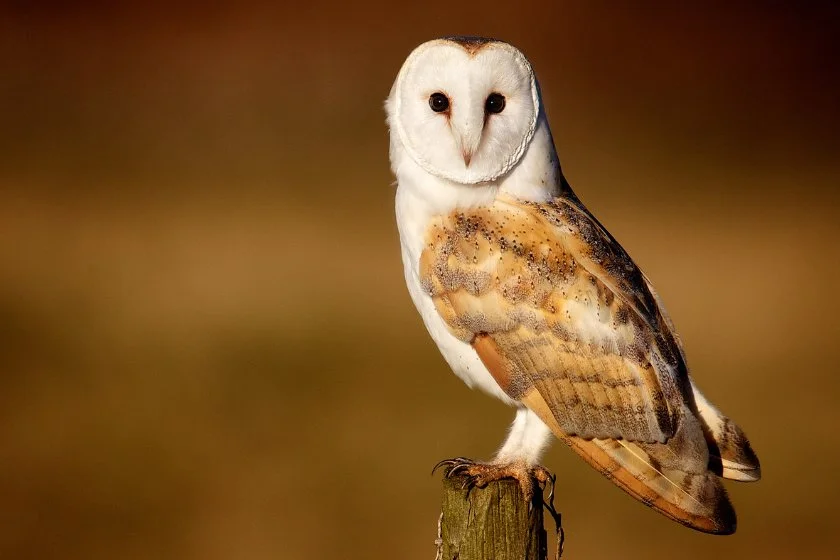
- Length: 13 to 16 inches
- Weight: 14 to 25 pounds
- Wingspan: 40 to 50 inches
- Scientific name: Tyto Alba
The barn owl is usually found in the southern parts of Wisconsin and is rare in other parts.
It is the most widely distributed owl in the world and can be found in all places except some Asiatic regions, the polar and deserts. It is also called the common barn owl.
This popular creature has been dubbed a lot of names, all of which have their significance.
It is named the barn owl because it lives in barns, the hoot owl because of its call, the church owl because it also dwells in abandoned churches, and a host of other names.
Its most prominent feature is the black eyes, which may be unsettling for someone meeting it for the first time.
Its overall color is a mixture of pale brown and gray. It can also be recognized by its broad wings and short tail.
There are three types of barn owls: the western barn owl, the eastern barn owl, and the American barn owl.
The last one is more prominent in Wisconsin. This species is usually nocturnal, but in Great Britain and some islands, it also comes out by day.
8. Long-eared Owl

- Length: 14 to 16 inches
- Weight: 8 to 15 pounds
- Wingspan: 35 to 39 inches
- Scientific name: Asio otus
The long-eared owl also goes by the names cat owl, lesser horned owl, or northern long-eared owl.
Its range extends from North America to Europe. In Wisconsin, these species live in dense trees. It is quite common in the state and easier to spot.
Both the long-eared owl and its relative, the short-eared, are under the genus Asio. The major difference is in their ear tufts, as the names state.
The long-eared owl is also characterized as having long wings, a slim figure, and long ear tufts. The latter seems to be a good communicative tool, but one can’t be sure.
The long-eared owl often makes a home out of nests left by other birds. It is what some would call a “specialized predator” as it has a particular dietary target.
It feeds almost exclusively on rodents. This nocturnal bird does most of its hunting at night.
9. Short-eared Owl
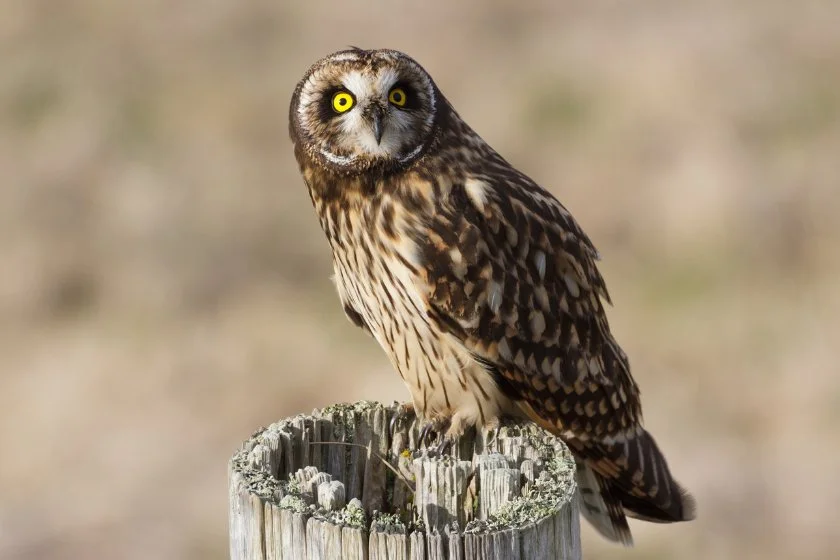
- Length: 14 to 17 inches
- Weight: 7 to 17 pounds
- Wingspan: 34 to 41 inches
- Scientific name: Asio flammeus
Just like the barn owl, the short-eared owl is located more in the south of Wisconsin, where it remains all year.
These birds only get to the northern parts of Wisconsin in their breeding season. They inhabit open grounds, and you can easily find them as they can be found during the day.
This bird is so named due to its almost invisible ear tufts, quite unlike its relative, the long-eared owl.
It is also known to have large eyes, a short neck, and broad wings. It also has a bill that’s black in color and very strong.
The short-eared has a raspy bark that would help you detect it with ease. It either goes like waowk-waowk-waowk or toot-toot-toot-toot.
It is often quiet during the winter but is more vocal when breeding.
The diet of the short-eared owl includes rodents and other small mammals like bats, muskrats, and moles. These birds can be nocturnal, diurnal, or crepuscular.
10. Snowy Owl
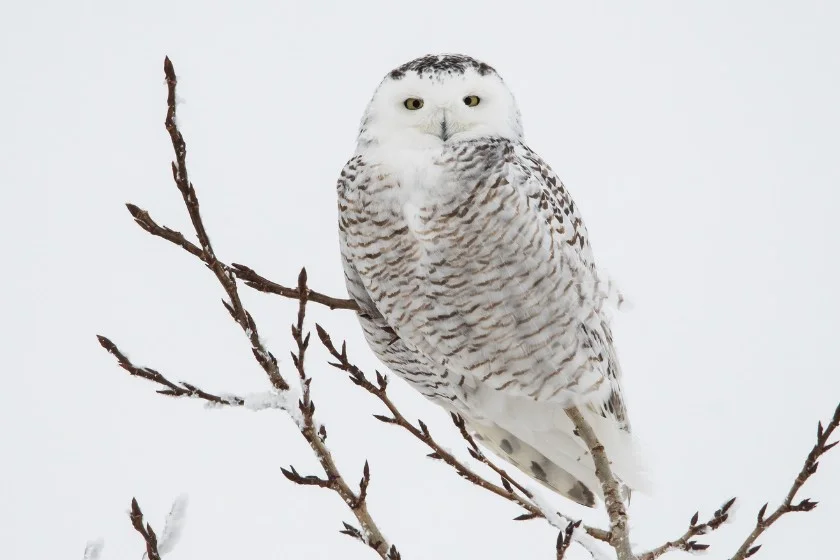
- Length: 21 to 28 inches
- Weight: 56 to 104 pounds
- Wingspan: 50 to 57 inches
- Scientific name: Bubo scandiacus
The snowy owl also goes by the names polar owl, white owl, and arctic owl. It is migratory and can usually be found stopping at Wisconsin before seeking other pastures.
It is large, white, and comes with a large wing. Altogether, it falls on the list of the biggest owls in the world.
Males tend to be whiter than their female counterparts because the latter has more dark brown markings.
Older individuals also tend to be whiter, though that’s not a set rule.
The uniqueness of the snowy owl isn’t in size or even color (though those are admirable).
The major advantage lies in its ability to hunt both during the day and at night. This makes them formidable predators.
11. Northern Saw-Whet Owl
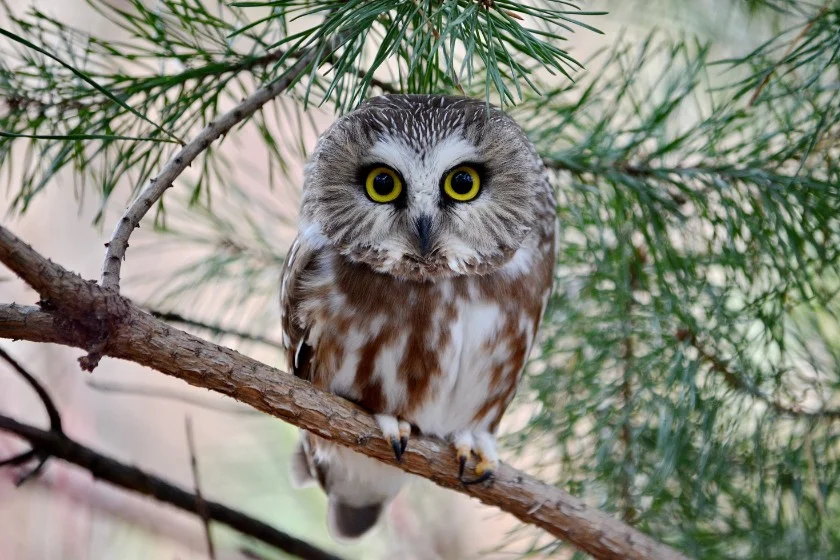
- Length: 7 to 9 inches
- Weight: 2 to 5 pounds
- Wingspan: 17 to 22 inches
- Scientific name: Aegolius acadius
The Northern Saw-Whet Owl earned its name from the sound it makes. Its sound is similar to a blade being sharpened with a whetstone, hence the name.
The Saw-Whet is common in Wisconsin, staying around throughout the year.
This owl is among the smallest in North America, with very sharp ears that it relies on when hunting in the dark. It feeds mainly on small mammals like rodents.
Its main physical features include a round, white face, a dark beak, and a pair of yellow eyes.
By comparison, it can be placed side-by-side with the short-eared owl as they both have no visible ear tufts. The Northern saw-whet owl is smaller, though.
Conclusion
Owls are exotic birds, and if you find yourself in Wisconsin, you may sight one or two.
Some are easier to see than others, especially those that are active during the day. There are up to eleven species of owls in Wisconsin featured on our list, each with its peculiarities.
Next up…
- Owls In Minnesota
- Owls In Indiana
- Owls In Michigan
- Most Dangerous Animals In Michigan
- Most Dangerous Animals In Indiana
- Most Dangerous Animals In Illinois
References & Notes
Facts Sources:
- Great Horned Owl. The Peregrine Fund.
- Geggel N. 2022. Are All Owls Actually Night Owls? Live Science.
